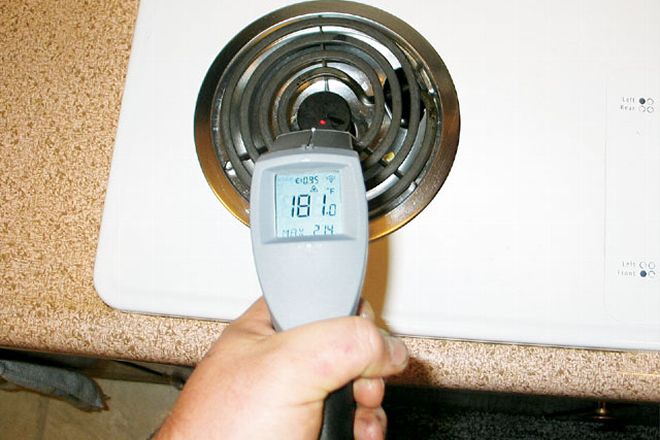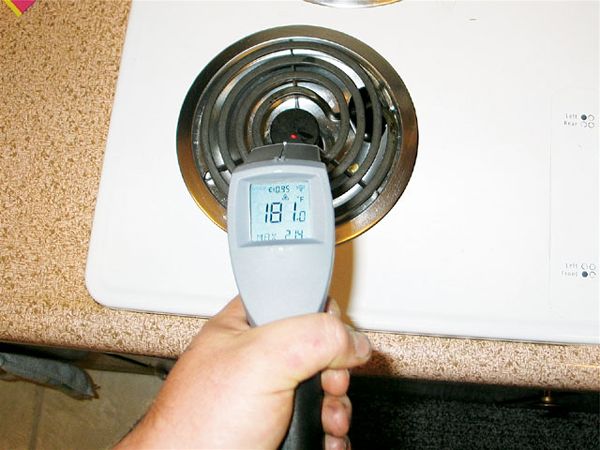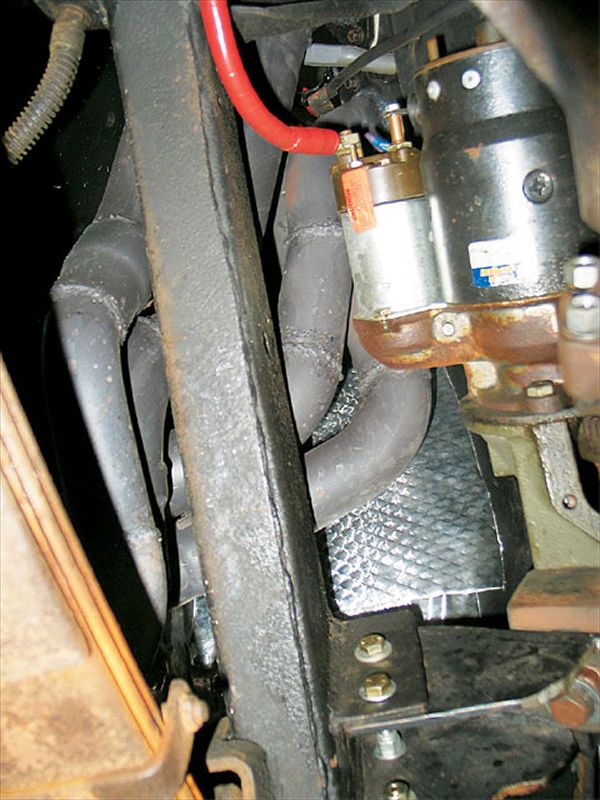
 Pete Trasborg
Brand Manager, Jp
Pete Trasborg
Brand Manager, Jp
 To put things in perspective, we shot our Summit non-touch thermometer at our stove. At the No. 2 setting, the center of the element is 181 degrees, or 1 degree hotter than the floor of our M-715 before any cooling steps were taken.
To put things in perspective, we shot our Summit non-touch thermometer at our stove. At the No. 2 setting, the center of the element is 181 degrees, or 1 degree hotter than the floor of our M-715 before any cooling steps were taken.
We've got this M-715 with a tall-deck Chevy big-block, custom-built fenderwell, exit headers, side pipes, and a sheetmetal interior. The floor is sheetmetal, the dash, door panels, and rear wall of the cab are also all sheetmetal. Since it is an M-series Jeep, this probably doesn't come as a surprise.
Don't get us wrong, we didn't intend to wheel this truck, but you know how that works out. So we planned for it by tucking the exhaust up as tight as we could. That's all well and good, but the problem is that a 2 1/2-inch exhaust with long tube headers built with 1 7/8-inch primary tubes and 40-series Flowmaster mufflers makes a lot of heat. When that whole mess is 2 inches or less from the sheetmetal floor, that makes for a very hot cabin.
To put it in perspective, in 30-degree weather we can take the truck out, and roll the windows down without the heater going and still drive comfortably in shorts and a T-shirt. To put it mildly, the inside of this truck is HOT (maybe we should have gone for 3 inches of clearance on the exhaust).
As we are writing this, summer is fast approaching, along with a possible 3,000-mile trip in this truck, and we just knew that the interior temperatures in the great American Southwest would be murder. Like the true Jeep people we are, we set out to cure our problems.
Look at the pictures and captions to get the idea of the path we followed, but the real useful information is in the table at the end of the story. Look at how the surface temperature of the floor affects the ambient temperature in the truck. Note for all testing, the sun was at its highest, and we had only the driver-side window of the truck open.
The Numbers
To be perfectly honest, we were amazed at both our measurements and our results. We started with a whopping 180 degrees on the floor of the passenger side, and by the end, had it down to 104 degrees in the hottest spot on the floor. Also, as a nice bonus, we were able to cut 6.5 decibels out of the cab, making for a less ear-shattering ride. We used a non-contact thermometer from Summit Racing to test the high and low temperature of the floor, as well as the temperature at the gas pedal where the driver's foot is the most. We used an indoor/outdoor thermometer for the ambient temperatures, and used a decibel meter for noise levels because that is what Dynamat is largely marketed for.
 We applied DEI's floor and tunnel shield under the truck in all the places the headers came close to the floor, then took the truck for a spin and noticed it wasn't as hot inside. The outside ambient temperature was also about 15 degrees cooler, so we didn't document this step. Instead, we went to the third stage with full measuring and documentation.
At Idle after 20 minutesAt 45 MPHAt 45 MPH
We applied DEI's floor and tunnel shield under the truck in all the places the headers came close to the floor, then took the truck for a spin and noticed it wasn't as hot inside. The outside ambient temperature was also about 15 degrees cooler, so we didn't document this step. Instead, we went to the third stage with full measuring and documentation.
At Idle after 20 minutesAt 45 MPHAt 45 MPH Our seat-of-the-pants impression was that the DEI floor and tunnel shield made the biggest improvement in ambient temperatures in the cab. Also, the single most noticeable change from the driver's seat didn't have to do with heat but with the sound-deadening of the doors; once the Dynamat was applied, all reverb went away. The heat loss was more of a progressive, step-by-step process - with each stage, it got more bearable.
Heat reduction and rust
In any open-top Jeep (and many with hardtops), water finds its way into the interior. Whether it's through the rotted canvas, leaving the top down, or through one of many door or window seals, water on the floor of a Jeep is a common sight.
Going into this, we already had a layer of Herculiner on the floor, and we visually inspected it and also ran a screwdriver over it. Occasionally, if the surface isn't prepared well, the Herculiner will lift and allow water to accumulate between the product and the metal. In our case, this wasn't a problem.
Before applying the Dynamat, we strongly suggest putting down a layer of Herculiner, POR-15, or other rust-inhibiting protectant. After letting it dry, put the Dynamat down and then Herculiner - or something similar - on top of it.
The Dynamat is a tar/rubber-like compound with a layer of adhesive on it that sticks like crazy. While we aren't concerned about where it sticks, the small contours that it isn't adhered to might allow water to pool. Our top layer of Herculiner should keep water out from any air pockets, but if/when it gets in, the base layer of Herculiner will keep the water from eating away the metal of the cab.





